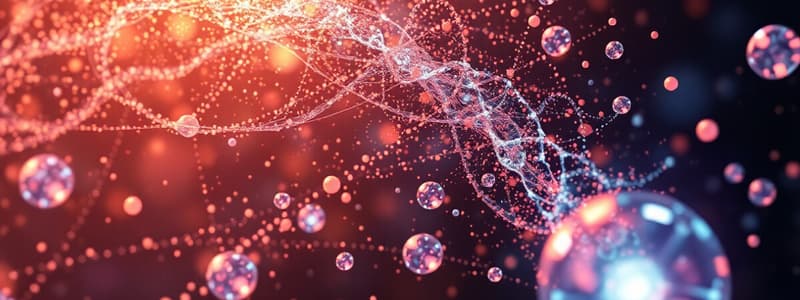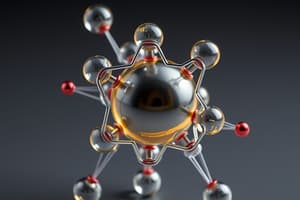Podcast
Questions and Answers
What is the phenomenon called that describes the random movement of small particles suspended in a fluid?
What is the phenomenon called that describes the random movement of small particles suspended in a fluid?
- Evaporation
- Diffusion
- Dissolving
- Brownian motion (correct)
All mixtures have a uniform composition.
All mixtures have a uniform composition.
False (B)
What is the chemical formula for pure water?
What is the chemical formula for pure water?
H₂O
A _____ is a material with a consistent composition and defined properties.
A _____ is a material with a consistent composition and defined properties.
Match the following mixtures with their components:
Match the following mixtures with their components:
Which of the following is an example of an aerosol?
Which of the following is an example of an aerosol?
Brownian motion provides evidence for the existence of particles.
Brownian motion provides evidence for the existence of particles.
What happens to salt when it dissolves in water?
What happens to salt when it dissolves in water?
Flashcards
Brownian motion
Brownian motion
The random jiggling of small particles suspended in a fluid caused by collisions with smaller invisible particles.
Dissolving
Dissolving
The process where a substance (solute) mixes evenly with another substance (solvent) to form a solution.
Substance
Substance
A material with a fixed composition and consistent properties.
Mixture
Mixture
Signup and view all the flashcards
States of matter
States of matter
Signup and view all the flashcards
Foam
Foam
Signup and view all the flashcards
Aerosol
Aerosol
Signup and view all the flashcards
How is a foam formed?
How is a foam formed?
Signup and view all the flashcards
Study Notes
Particle Model
- Brownian motion is the random movement of small particles suspended in a liquid or gas due to collisions with smaller, invisible particles.
- Dissolving is the process where a solute mixes with a solvent to form a solution. This process provides evidence for the particle model.
- Brownian motion shows that even particles too small to see have an effect when they collide with larger particles.
Substances
- A substance is a material with a consistent composition and defined properties. Examples include water, gold, and oxygen.
- A mixture contains two or more substances physically combined, but not chemically bonded. Examples include saltwater, air, steel, and sand and water.
Examples of Substances
- Water (H₂O): Composed of two hydrogen atoms and one oxygen atom, having consistent composition and defined boiling/freezing points.
- Gold (Au): Uniform composition with defined physical properties like density and melting point.
- Oxygen (O₂): A pure substance made of oxygen molecules.
- Table salt (NaCl): A pure substance with a consistent chemical formula consisting of sodium and chlorine.
Examples of Mixtures
- Saltwater: A mixture of water and dissolved salt. The salt is physically combined and can be separated by evaporation.
- Air: A mixture of gases (nitrogen, oxygen, carbon dioxide, argon, and water vapor).
- Steel: A mixture of iron, carbon, and sometimes other metals, creating an alloy.
- Sand and water: A physical combination of sand particles and water that can be separated by filtration.
States of Matter
- Foam: A mixture of gas bubbles dispersed in a liquid or solid (e.g., whipped cream).
- Aerosol: A mixture of fine liquid droplets or solid particles suspended in a gas (e.g., spray deodorants)
- In foams, gas particles are trapped within the liquid or solid structure. In aerosols, particles are freely dispersed in the gas.
- A foam forms when small gas bubbles are trapped in a liquid or a solid.
Studying That Suits You
Use AI to generate personalized quizzes and flashcards to suit your learning preferences.




